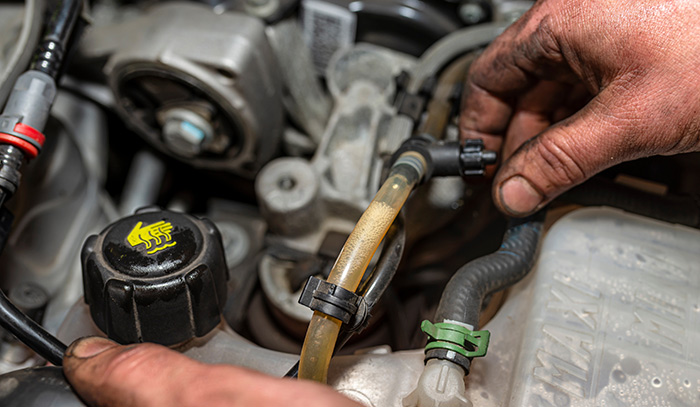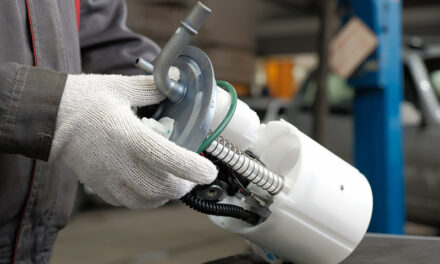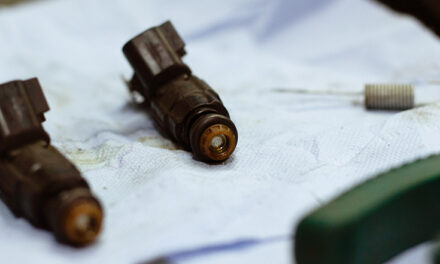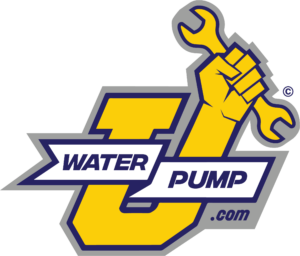Replacing components of the fuel system doesn’t have to be expensive – it is something most people are able to do themselves with some hand tools. Always remember, when working with fuel system replacement parts, that you are working around gas, so common-sense warnings apply, such as not smoking while working. Something most people don’t think of is static electricity. A spark from your clothing could set off a fire. It’s important to use proper safety precautions when working with fuel.
Fuel Filter
Replacing a fuel filter is one of the easier parts of fuel system replacement. Generally, the fuel filter is located underneath the vehicle and is bolted onto the frame. Make sure you have the proper tools. Some fuel filters require fuel filter removal tools while others are held on with hose clamps. Generally, fuel-injected vehicles have some type of snap lock because of the pressure in the fuel lines. Carbureted vehicles may use hose clamps as they generally have less than 12 psi running through the lines. When installing the new filter, be sure to check the direction of flow. Fuel filters have arrows that point to the front of the vehicle. Make sure the arrows are pointing toward the front or you’ll restrict or completely stop the flow of fuel. Fuel filters may be metal or plastic. Be sure to get the right type for your vehicle. Metal filters last longer, but you can see through plastic filters to check for dirt and debris.
Fuel Pump
Replacing a fuel pump means removing the gas tank on most vehicles. If you are working on an older vehicle with a carburetor, it’s quite a bit easier.
Carbureted Vehicles
Because a carbureted vehicle doesn’t have much pressure and the fuel pump is usually on the side of the engine, it’s a matter of placing a rag under the fuel pump and removing the lines. The rag will soak up the little fuel that spills. Make sure the lever on the pump is placed under the camshaft so that it pumps properly.
Fuel Injected Vehicles
The fuel pump in a fuel-injected vehicle is usually located in the gas tank. Before you lower the tank, siphon the fuel into a gas can to lighten the load. Keep in mind that the vapors are more explosive than the liquid fuel. Remove the clips that hold the cover on the gas tank, but don’t use a metal punch to do it – it could create sparks. Use a hard plastic or wooden punch to turn the cover. Make sure you also change the filters on the fuel pump, if any. In most cases, the pump has a sock that should be changed. Fuel Injectors Keep in mind that the fuel system is pressurized. When removing the fuel rail from the top of the injectors, you could be sprayed with the fuel that is in the rail. Place a rag under the connector from the fuel line to the rail, and if possible, place a rag over the top of the fuel rail where you are disconnecting it. The rags catch the gas and keep it from spraying all over the place when you loosen the nuts. Once the pressure has been relieved, you will be able to remove the top rag. In some cases, you may be able to unbolt the rail and move it aside while still attached to the fuel line – it depends on whether the line is rubber or metal.




![[Sethparts] - Has Long Been Renowned for Providing Durable Performance Auto Parts. We Know Exactly Which Engines and Specs We are Making Products for. [Attention Please] - Please Use "amazon confirmed fit" to Verify Fitment before Purchasing,Because ...](https://m.media-amazon.com/images/I/416dY4bFv3L._SL100_.jpg)
![[Notice] Make sure will fit your vehicle check"fitment information", Please use Amazon's Your Garage feature above to see if this part is compatible with your vehicle. [Performance] Enhance your vehicle with our top-quality fuel injector. Made from c...](https://m.media-amazon.com/images/I/41ZM5hW2aqL._SL100_.jpg)



![[Fuel Pump Vehicle Fitment]: Compatible with 2004 for Buick Rainier L,2003-2004 for Chevy SSR L,2002-2004 for Chevy Trailblazer EXT L,2002-2004 for Chevy Trailblazer L,2002-2004 for GMC Envoy L,2002-2004 for GMC Envoy XL L,2004 for GMC Envoy XUV L,20...](https://m.media-amazon.com/images/I/41a2nDiT8uL._SL100_.jpg)